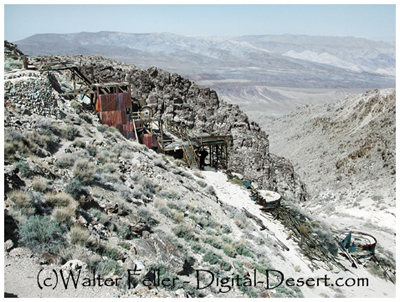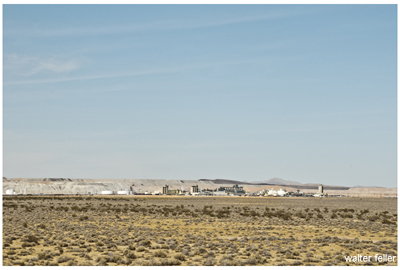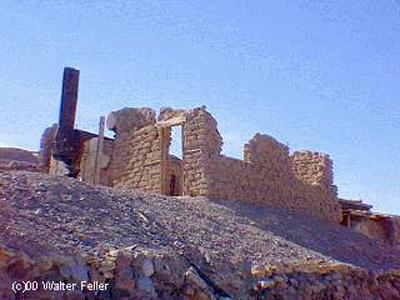Just a Year Earlier
Just a year earlier, in 1913, John Suckow, drilling for water on his homestead claim, at a depth of 40 feet discovered the largest borax deposit in the world, scarcely three miles north of the Santa Fe Railroad, about 10 miles northwest of Kramer. Immediately Smith’s Pacific Coast Borax Company bought up the property. In 1927 the Death Valley operations were moved to the Baker Mine near Boron.Just as the discovery of the Comstock Lode rocked southeastern California, the discovery of silver at Tonopah on May 19, 1900 and the subsequent discovery in 1902 of gold at Goldfield scarcely 25 miles away, sent prospectors scampering through out the region looking for gold.
Gold discoveries in the immediate aftermath of Goldfield include Skidoo (1906), Harrisburg (1905), Hart (1907), and Crackerjack (1906). In 1905 the Los Angeles and Salt Lake Railroad (later the Union Pacific) was constructed south through Las Vegas, connecting with the Santa Fe at Daggett. The close proximity of this new line to mines located south of Mountain Pass proved to be a stimulus to that district.
A rail line was built in 1907 from Barnwell (Manvel) to the booming gold camp of Searchlight. The line skirted the north edge of the newly established town of Hart. At this time the use of the automobile was becoming widespread, and soon became as essential to the desert prospector as the burro had been. Also, gasoline motors were beginning to be used in mills, replacing steam powered equipment. By the mid 1910s trucks began to be utilized to haul ore. Electric power was furnished by lines from the newly constructed Los Angeles aqueduct or, as was in the case of Bodie and Calico, generated locally.
Another stimulus to mining in the late in the 1800s and in the early years of the 1900s was the relatively high price of copper. The Copper World Mine, discovered in 1869, was systematically mined beginning in 1898. Ore was smelted west of the mine at Valley Wells. After reduction at the smelter, the nearly pure copper was teamed to the California Eastern Railroad at Manvel, 30 miles southeast. Supplies and coal from New Mexico were hauled in on the return trip. Three or four times a month a 20-ton carload of copper matte was shipped to New York for final smelting. Each rail car of matte was worth $7,000. By late 1899 the Copper World was said to be one of the four largest copper mines in the United States. Even though the California Eastern Railroad was extended 13 miles closer to the property in 1902, the mine sputtered and closed. The costs were simply too high. Between 1906 and 1908 the mine was again active. During this time ore was shipped to the Needles Smelter.
Previous - Next

Skidoo Mill - Death Valley

Rio Tinto - Boron, Ca.

Harmony - Death Valley